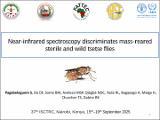| dc.contributor.author | Pagabeleguem, S | |
| dc.contributor.author | Da, DF | |
| dc.contributor.author | Some, BM | |
| dc.contributor.author | Avelessi, MSP | |
| dc.contributor.author | Djègbè, NDC | |
| dc.contributor.author | Yoda, RL | |
| dc.contributor.author | Bagayogo, A | |
| dc.contributor.author | Maïga, H | |
| dc.contributor.author | Churcher, TS | |
| dc.contributor.author | Dabire, RK | |
| dc.coverage.spatial | BURKINA FASO | en |
| dc.coverage.spatial | NIGERIA | en |
| dc.coverage.spatial | SENEGAL | en |
| dc.date.accessioned | 2025-11-04T08:32:09Z | |
| dc.date.available | 2025-11-04T08:32:09Z | |
| dc.date.issued | 2025 | |
| dc.identifier.uri | http://repository.au-ibar.org/handle/123456789/1755 | |
| dc.description.abstract | The Near-infrared spectroscopy (NIRS) technique, a promising newgeneration monitoring tool, appeared to be a reliable alternative for
identifying tsetse flies | en |
| dc.format.extent | 11p. | en |
| dc.language.iso | en | en |
| dc.publisher | AU-IBAR | en |
| dc.subject | Tsetse and Trypanosomiasis Control | en |
| dc.subject | 37th General Conference of the International Scientific Council for Trypanosomiasis Research and Control (ISCTRC) | en |
| dc.subject | Near-infrared spectroscopy | en |
| dc.title | Near-infrared spectroscopy discriminates mass-reared sterile and wild tsetse flies | en |
| dc.type | Conference | en |
